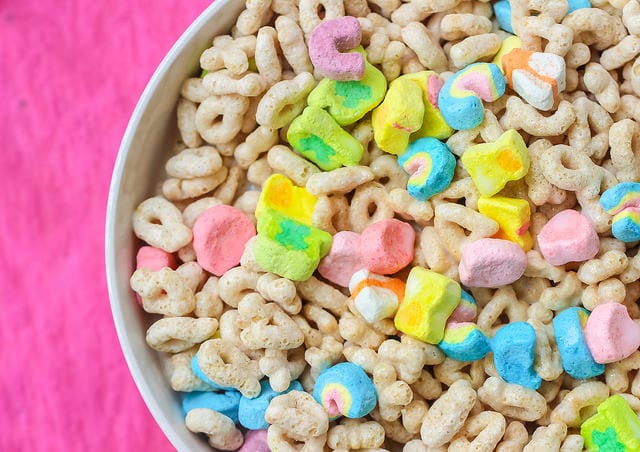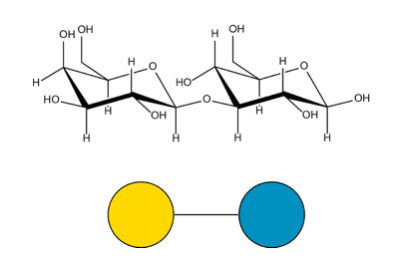
Hearts, stars, horseshoes, clovers and blue moons, pots of golden rainbows and me red balloons! If you've ever eaten Lucky Charms cereal, you probably know this jingle and the tiny shapes of marshmallows it references. Interestingly enough, glycobiologists, or biologists who study the sugars that make up those tasty mallows, have their own Lucky Charm code for the carbohydrates they study.
Carbohydrates are diverse and come in many different forms – each with a unique chemical makeup and properties. The sugar code, with its current twelve shapes and nine colors, evolved as a way for glycobiologists to represent the complex chemical structure of sugar chains in presentations and figures. But to someone new to the field, this crazy collection of colored shapes may seem strange and unfamiliar. I remember being thrown for a loop by the colorful models in glycobiology papers when I started out as a lab technician at the Complex Carbohydrate Research Center. Once I realized there was meaning and intention behind the selection of those colors and shapes, the symbols seemed logical. So for this blog, my goal is to decipher the sugar code for you.
Colors
Each symbol in the sugar code represents a different monosaccharide or single sugar unit. The color of the symbol represents the basic structure of each sugar. The same color is used for different monosaccharides with the same stereochemistry, or spatial arrangement of atoms. For example, every symbol with a yellow color has an arrangement of atoms like galactose. Here is a list some colors and the basic sugar stereochemistry they are associated with:
Green – Mannose stereochemistry
Blue – Glucose stereochemistry
Yellow – Galactose stereochemistry
Red- Fucose stereochemistry
So if you see a blue square you know that sugar has an arrangement of atoms similar to glucose because of its color, but what about its shape?
Shapes
Every symbol in the sugar code also has an associated shape, which tells you something about the composition of the sugar's functional groups, or collections of atoms attached to the sugar's carbon skeleton. The most basic shape is a circle, which represents a hexose sugar. The other shapes indicate some kind of modification to this basic hexose structure. For example, a square indicates an N-acetyl group is attached to one of the carbons. Here is a list of some shapes in the sugar code and the functional groups they are associated with:
Circle – Hexose sugar
Square – Hexosamine with N-acetyl group
Diamond – Hexuronate with an Acidic group
Triangle – Deoxyhexose sugar
There are various exceptions to these general rules for color and shapes, but for the most part knowing these standards will help you apply some meaning to the symbols drawn in glycobiology figures.
Putting It All Together
Both the shape and color of a unit in the sugar code imparts meaning about the chemical composition of that sugar. With this new lens, let's take a look at a common sugar we come across in daily life: lactose.
Sitting in your fridge right now is likely some milk. This milk, if it comes from cows, contains lactose. Lactose is a disaccharide of two sugar units, a galactose and a glucose. So how would we draw this sugar using the sugar code?
Galactose and glucose are both hexoses, so their shape will be a circle. Galactose will be yellow and glucose will be blue. A glycobiologist would represent this disaccharide as a yellow circle linked to a blue circle. Ta-da! You're basically a glycobiologist in training, and you didn't even know it.

Why Have a Code?
The sugar code enables glycobiologists to more effectively and efficiently communicate with one another and the public. Part of being a good scientist, or in this case a good glycobiologist, is being an effective communicator of our research. The symbols in the sugar code allow us to do just that. However, it's important for us glycobiologists to remember that not everyone we talk to about our science has encoded deep meaning to our sugar code.
Hopefully, you're feeling less confused about the sugar code after reading this blog. Just think of the sugar symbols as emojis for glycobiologists! Similar to how it took my grandma some time to jump on the emoji bandwagon, it may take some time to use the sugar code effectively. But like everything, it just takes practice! Now if only Apple would include sugar code emojis in their next software release… a glycobiologist can dream, can't she?!
About the Author:
 Stephanie M. Halmo is a former middle school science teacher turned graduate student, actively pursuing her Ph.D. in biochemistry from the University of Georgia. Stephanie currently serves as an Assistant Editor for Athens Science Observer. In her spare time she likes to dance, volunteer at local schools and tie-dye anything she can get her hands on. You can connect with Stephanie on Twitter and Instagram @shalmo or by email: shalmo27@uga. More from Stephanie M. Halmo.
Stephanie M. Halmo is a former middle school science teacher turned graduate student, actively pursuing her Ph.D. in biochemistry from the University of Georgia. Stephanie currently serves as an Assistant Editor for Athens Science Observer. In her spare time she likes to dance, volunteer at local schools and tie-dye anything she can get her hands on. You can connect with Stephanie on Twitter and Instagram @shalmo or by email: shalmo27@uga. More from Stephanie M. Halmo.
About the Author
- athenssciencecafehttps://athensscienceobserver.com/author/athenssciencecafe/April 17, 2020
- athenssciencecafehttps://athensscienceobserver.com/author/athenssciencecafe/April 12, 2020
- athenssciencecafehttps://athensscienceobserver.com/author/athenssciencecafe/April 3, 2020
- athenssciencecafehttps://athensscienceobserver.com/author/athenssciencecafe/March 30, 2020







